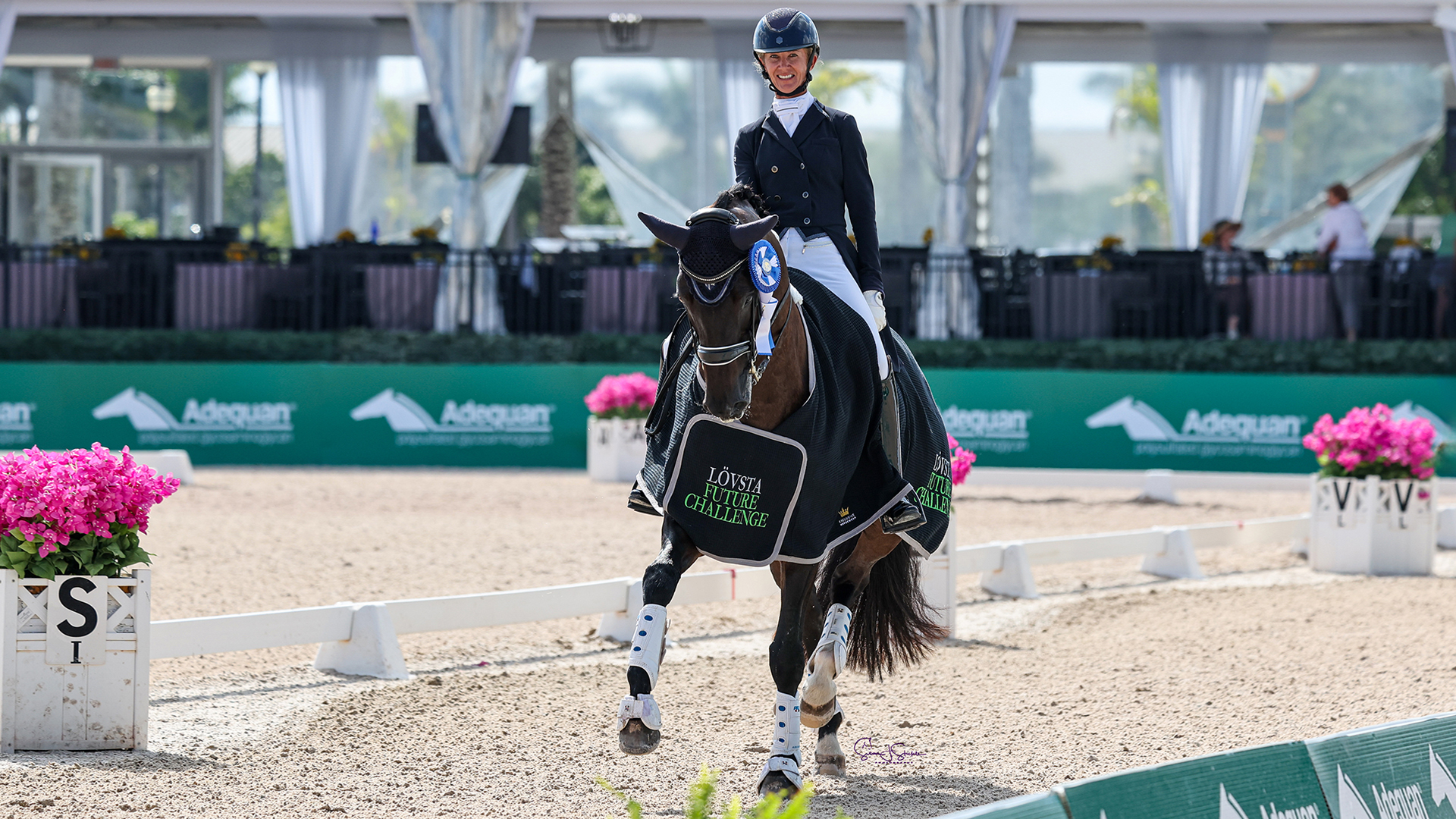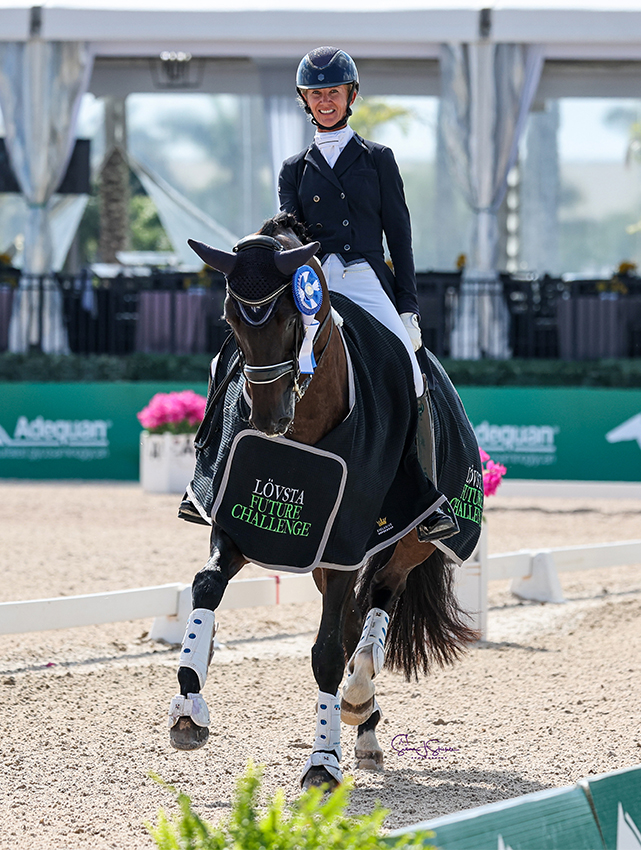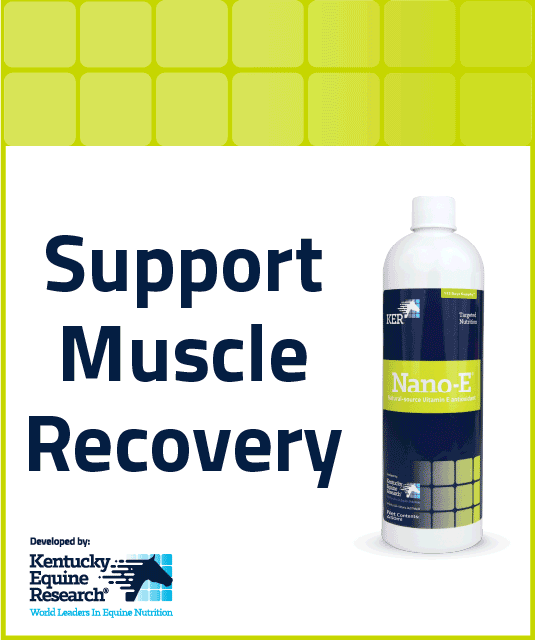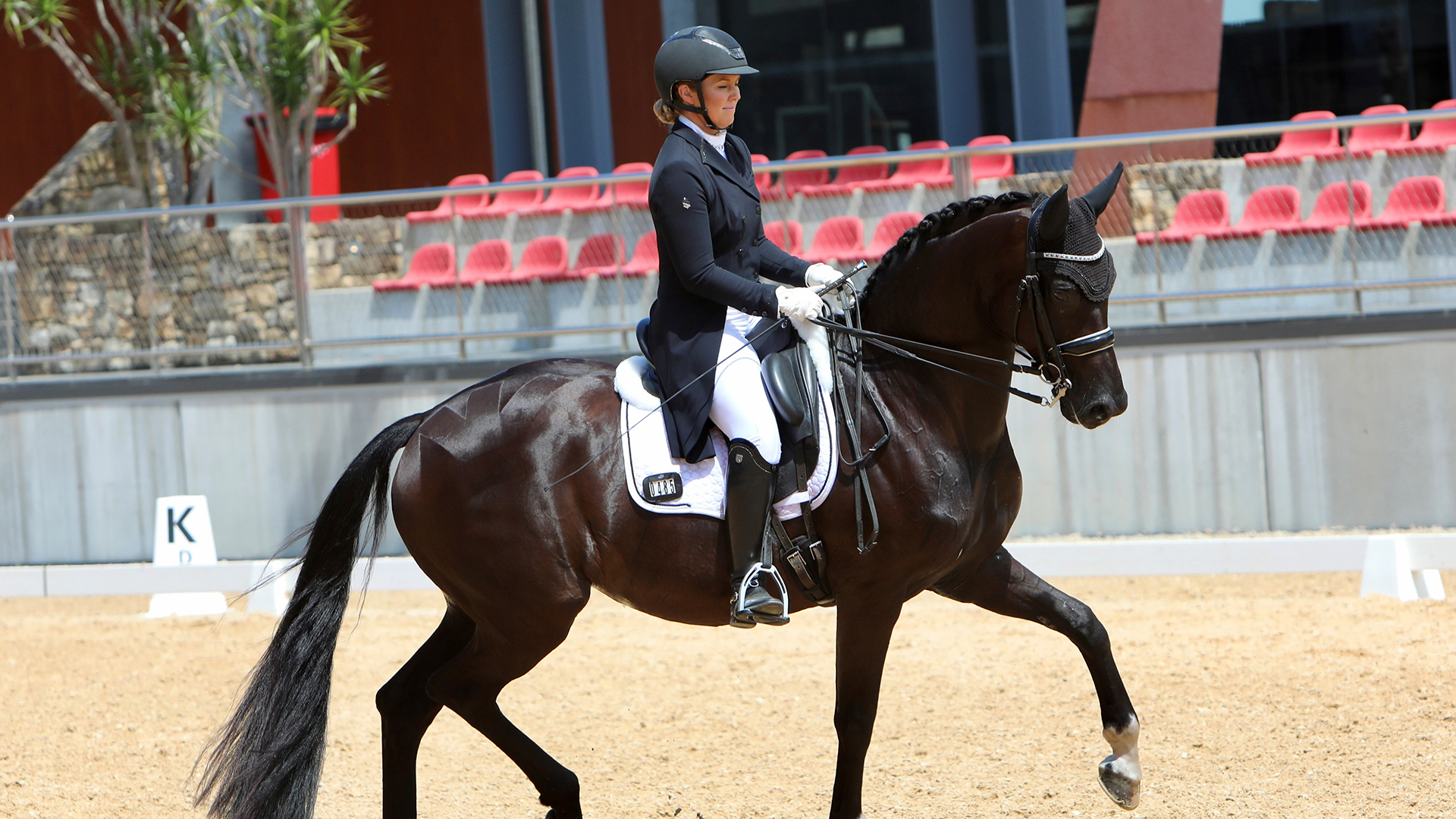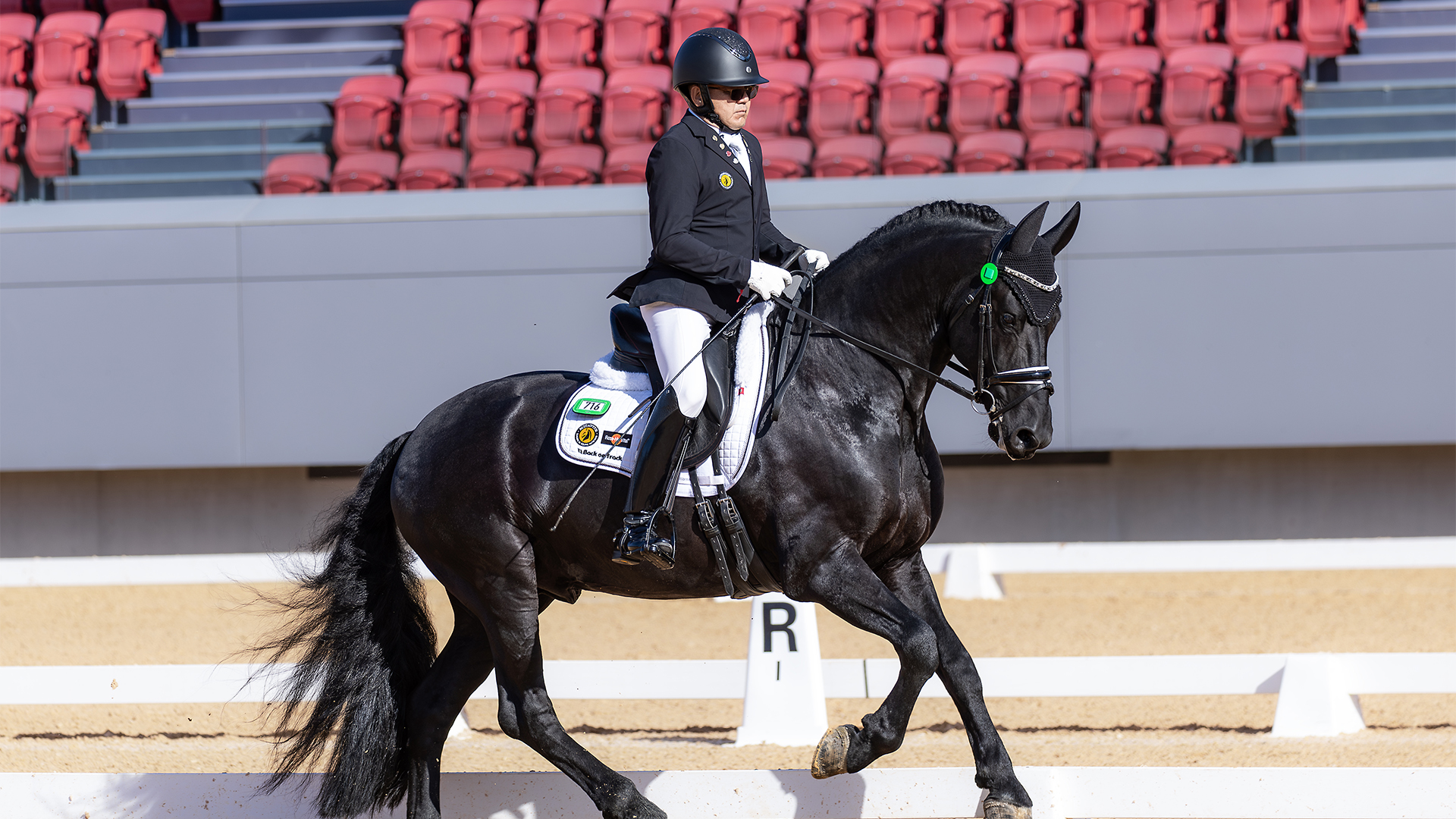Australian Olympian Kelly Layne was born into a horsey Queensland family and has gone on to take her love of dressage to an international level. Anchoring herself in the horse heaven of Wellington, Florida for the past 17 years, she has now joined Team USA.
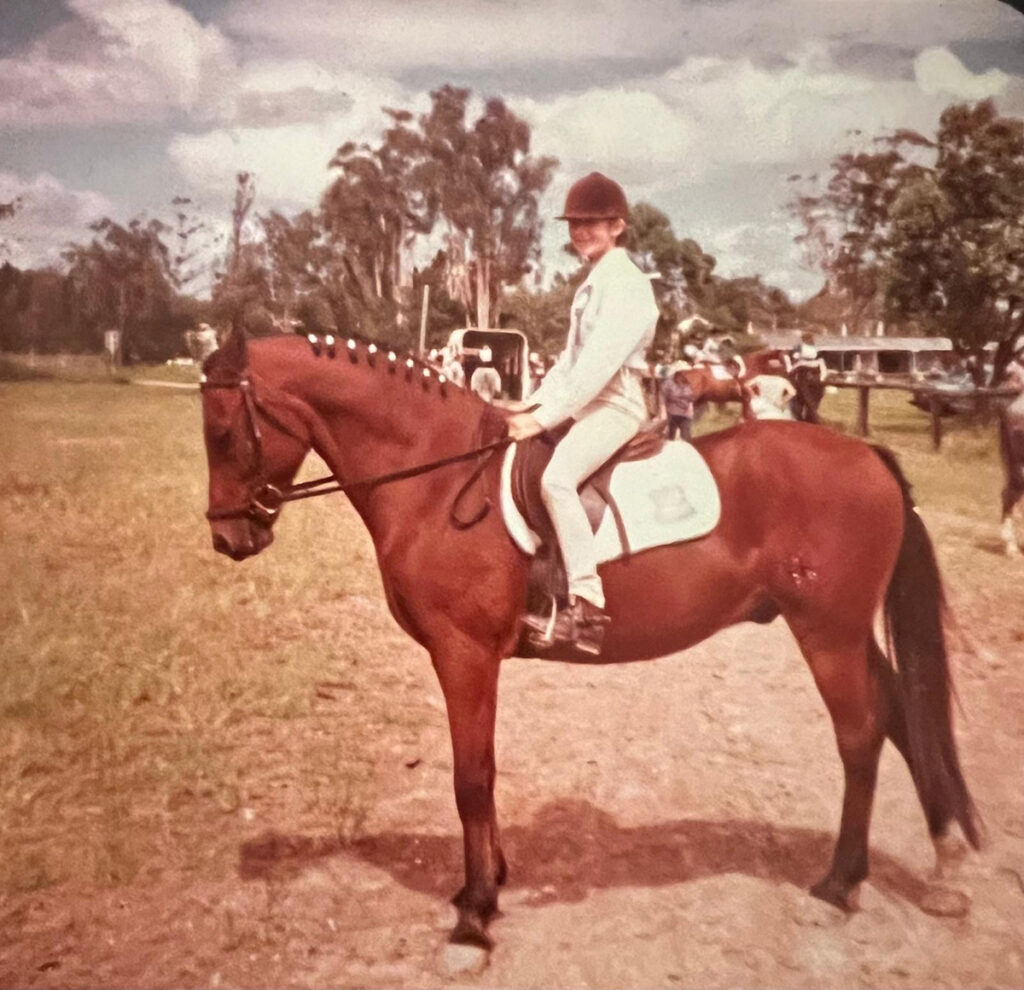
Kelly Layne was born into a horsey family in Queensland and rode throughout her childhood. Image supplied.
“Horses are my life;
horses are our lives…”
Kelly Layne was born in Brisbane and her mother, Helen Anstee, bred Warmblood horses and produced her first Grand Prix horse from breeding it right through to the top level. Kelly says she did it totally by herself and was quite the achiever! A great accomplishment looking back on those days. Her mum was also an A-level judge and a very wise and experienced dressage enthusiast.
Kelly had little chance of escaping the competition ring and was competing in Pony Club dressage at the age of 12. She won National Pony Club Championships for under-12s and again from 12-15 years. Kelly also had a very remarkable career riding show horses. She was Champion Rider several times at many Royal Shows and was riding ponies to Champion titles at Sydney, Melbourne and Brisbane Royals. This path from the show ring to the dressage area is one several riders have taken, including Judy Dierks, Maree Tomkinson, Caroline Wagner and now Jemma Heran, just to mention a few.
HELLO, AMOUCHEUR
On returning to Australia from that training trip, fellow Aussie Bennet Conn contacted Kelly to say he had a horse he thought would suit her. This horse was Amoucheur and Kelly had a Japanese client who agreed to buy this horse for her. He was big, bold, sensitive and very excitable. Kelly loved the horse and trained it through to Grand Prix.
When Kelly returned to Australia, she met another love of her life, her husband, Steve Layne, an American who was in the US Air Force as an F16 fighter jet pilot.
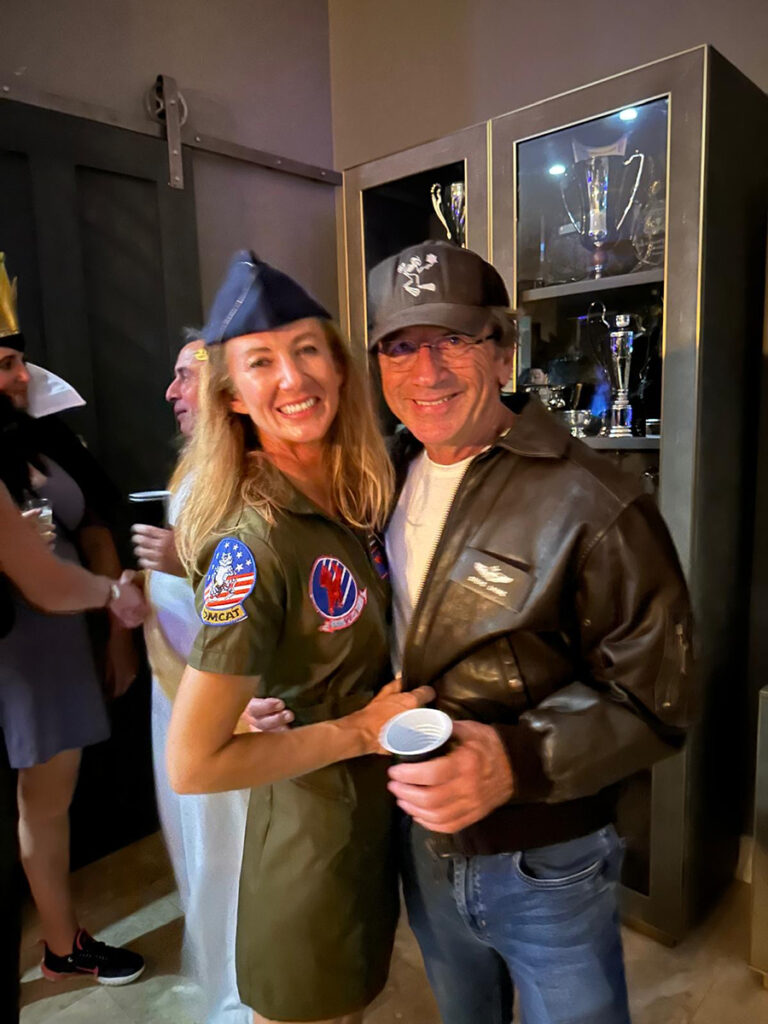
Kelly and her husband, Steve Layne. Image supplied.
During the training phase with Amoucheur, Kelly says she was so lucky that she was able to fly Harry Boldt over from Western Australia. She and Ricky Macmillan would have private lessons with him for three days at a time every couple of months. The training method again was along the lines of Willi Schultheis. In hindsight, she cannot believe how lucky she was to have the input of such an internationally famous icon as Harry Boldt. All the same, she had always wanted to train with Ulla Salzgeber. When Ulla came out for Equitana Brisbane in 2002, Kelly was very excited. Ulla then came to Australia and gave clinics that Kelly attended, out of Sydney at Ann Serrao’s property. At this time Marie Bruce was on a squad with a chestnut gelding Neversfelde Feuer and Kelly’s Japanese client saw Feuer there and fell in love and had to have him! Now Kelly had not only Amoucheur, but also Feuer.
Kelly took the horses to Europe where she made the team for the 2006 World Equestrian Games in Aachen with Amoucheur. It was after this that Kelly went to train with Ulla Salzgeber, a dream come true for a while, along with the other Australians there including Ann Serrao, Kate Taylor-Wheat and Lyndal Oatley.
“It was eye-opening for Kelly
to realise how this talented
horse just kept getting better…”
After her time at Ulla’s, Kelly came back to Australia. It was at this stage Kelly decided that with Amoucheur now 15 years old, it was perhaps time to sell him, a decision she regrets to this day. He was sold to Japan and went on to be Japan’s National Grand Prix Champion at the age of 17, 18 and 19. It was eye-opening for Kelly to realise how this talented horse just kept getting better and better and she is still sad she sold him a little too early.
TIME FOR A CHANGE
It was at this stage of Kelly’s life that she felt she needed to change; her father had passed away, and times were a little tough mentally. Husband Steve had been given a very good job opportunity in the States which he took up in 2008. Kelly wasn’t looking to move there to ride horses at all, she was following her husband’s pursuit with work. Kelly had been in Europe for a couple of years and the change was a welcome one. Steve suggested they could just go and have a try for a couple of years and that was 17 years ago!
Originally living in Colorado, Kelly says it was actually beautiful but not the place if you wanted to ride dressage. She convinced Steve to go to Florida to do the Wellington thing! Just for a short while and then do the San Diego thing with Steffen Peters, and then go home!? Kelly’s two stepchildren travelled the world with her and Steve all through Europe, Colorado and then Florida. It wasn’t until they moved to Florida that they stopped talking about going home to Australia.
Kelly admits the children didn’t really even want to go to college but once in Florida they were talking about which colleges they wanted to go to! They both become quite outstanding individuals. Their son is an underwater explosives expert in the US Navy and, as Kelly says, she doesn’t even really know what he does. Their daughter works for an aerospace company as a photonics engineer. Again, an amazing job and obviously following in their father’s footsteps. Neither showed any interest in dressage or horses.
The family ultimately settled down near the equestrian mecca, where they bought a house and Kelly could rent a barn nearby.
AUSTRALIAN OLYMPIAN
In 2021, Kelly had a beautiful bay horse representing Australia at the Tokyo Olympics called Samhitas. Unfortunately, horses are horses, and he got his tongue over the bit after the extended trot and ruined his chances of good percentages at that competition. Kelly was also nominated for the team at the 2016 Rio Olympics with a horse called Udon P. He was a huge horse with excellent piaffe and passage and as light as a feather. It just wasn’t their time in the lead-up to Rio; from the time they arrived in Europe, they were plagued with bad luck and as a consequence did not get a start on the team at Rio.
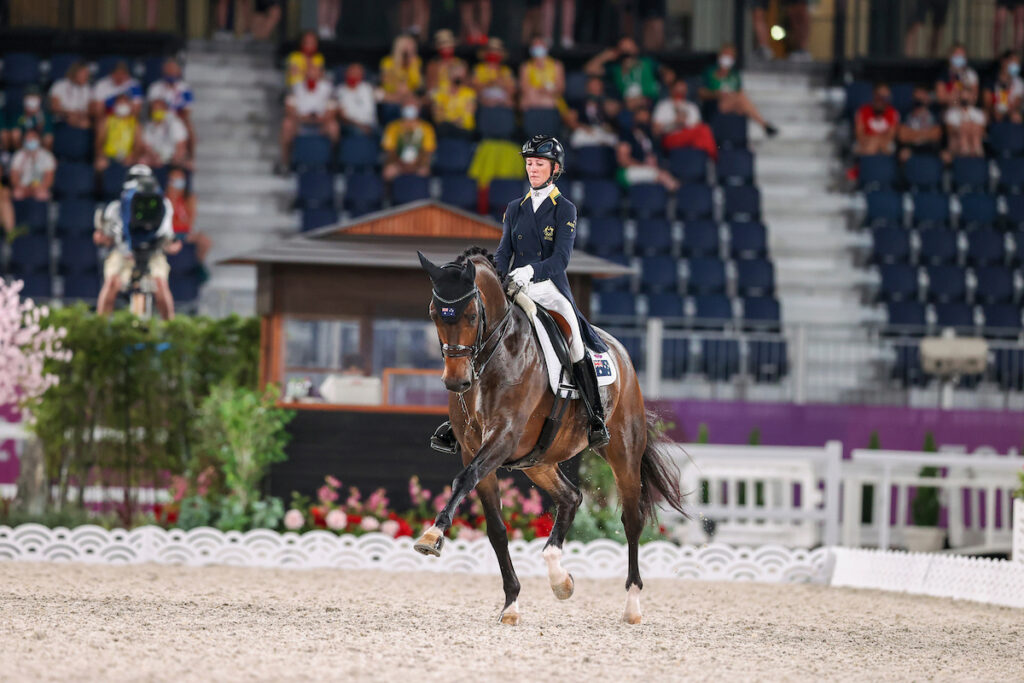
Kelly and Samhitas competing for Australia at the Tokyo Olympics. Image by Hippo Foto – Dirk Caremans.
“We were lucky in some ways with Covid,” Kelly adds, “that we could keep going where we could just keep training and showing, and I had Samhitas as a 10-year-old and he was probably pushed along a little quickly during that time and he made it to the Olympics. In hindsight it was probably a little too early in his career for that competition, and then on the other hand Udon was 15 leading into Rio and was probably a little past his prime.”
As an Australia entering CDIs in the USA and preparing for team selection, Kelly says it was relatively straightforward: “There was no problem getting started. There was no problem communicating with EA in Australia and the was no problem with them ratifying my entries. [The team selection process] was not difficult. The rules are clear… and I never had any problems whatsoever. In fact, I think it was probably easier to run my own boat and do my own competitions; and for the selectors, they just simply see the scores and go from there. I didn’t get caught up in any political commentary. I was just able to do my own thing to the best of my ability, and perhaps it worked in my favour a little.”
When asked whether she viewed it as an advantage or disadvantage to be competing outside of Australia during selection trials, Kelly says it’s a good question – there are of course pros and cons. “In some ways it’s an advantage to be competing outside of Australia because there are more competitions, more exposure to more judges and way more exposure to different competitors as you never know who you are going to come up against. In Australia, you’re always competing against the same people all the time, so the rankings are difficult to break up.” From a funding perspective, Kelly recalls there was some available in the early days – although not as much in recent years. “From memory, in 2006 there was some funding to help us go and train… some competition expenses and hotel accommodation was paid for. After that, there was little funding or help in the campaign for Rio in 2016… it helped out with hotel expenses, but that was about it. It was pretty minimal. The training with Ulla was so helpful at that time. I remember there was some funding to help fly Ton de Ridder to the States to help the Australian riders, so that was of benefit as well.”
LOCATION, LOCATION
During the competition season in Wellington, there are 12,000 horses stabled there. These days, Kelly leases 20 stables in a barn of 300; the facilities associated with the barn are simply amazing. Vets, physios, farriers, acupuncturists and the likes all within walking distance. You have never seen such high-quality indoor arenas, outdoor arenas and showjumping arenas all for training, including one 70m x 35m indoor. The barn is six minutes by horseback from the Palm Beach International Equestrian Centre, where there are national classes every week and CDIs every second week during the Global Dressage Festival, held for three months over the winter season when the weather is favourable.
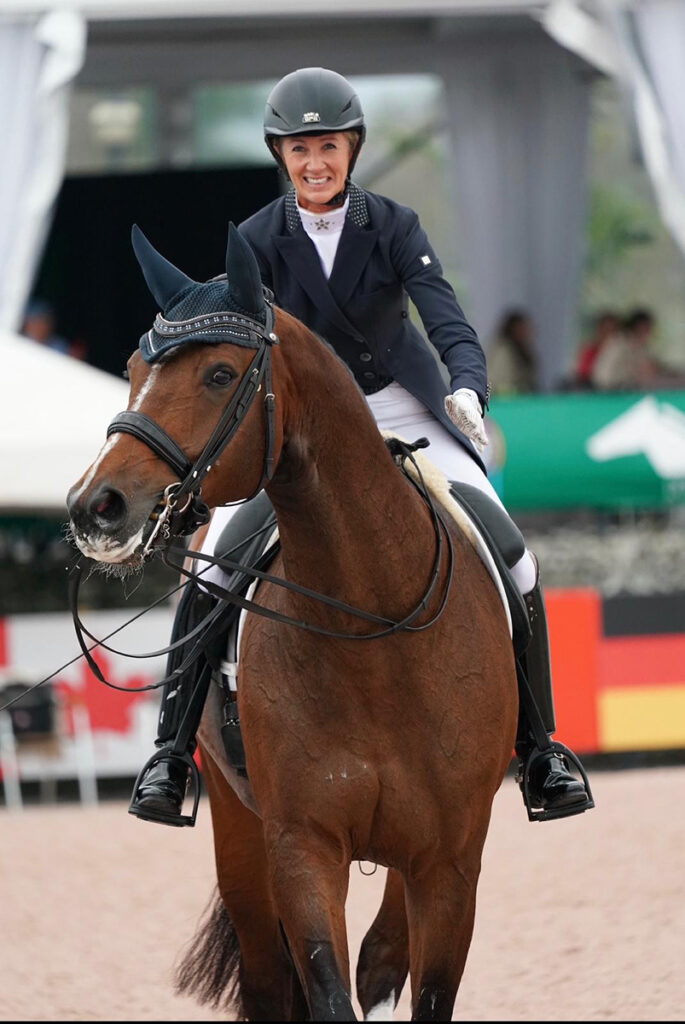
Kelly Layne and Fernando; this horse was named the 2023 United States Dressage Federation Grand Prix Horse of the Year. Image by Satomi Ishikuri.
Kelly says the availability of competitions and training is incredible: “It’s just on a whole new level.” Kelly and Steve have not looked back since moving to Florida and Kelly has a huge following.
Over the last 15 years, Kelly has developed a very successful business. She has eight Grand Prix horses in training for owners where Kelly will ride and train them during the week and the owners ride them at the competitions. Kelly loves their attitude. She says the horses are simply amazing and could be Olympic level horses. The riders have an absolute joy in competing and the whole attitude and friendship amongst everyone is quite incredible.
Last season, with her group of riders and horses that she coaches, they rode 115 tests at the national competitions during that winter season. Kelly rides between six and eight tests every week at the competition ground. Her owners buy truly beautiful horses and it’s a pleasure riding and schooling them, so the owners have easy rides when they get on.
One of Kelly’s clients is 74 and rode an Inter II for 67% on a mare that was a showjumper and now trained to Grand Prix. She also has two wonderful ladies in their late 60s who have seriously top Grand Prix horses that could easily get big percentages if ridden professionally in CDI classes, but they love every moment of competing on their own horses. “It’s fun for them as much as they take it seriously and the whole vibe is pleasurable and fun. It’s really what the sport is also about here at the national shows,” says Kelly. Kelly says it’s a different world in Wellington, but so exciting and so much fun! Working with wonderful people and good horses has got to be seriously exhilarating. “It’s literally like competition horse heaven, I have to say, and I feel like one of the luckiest people to be given these opportunities to deal and ride with such wonderful people with their beautiful horses. When you warm up in the national classes you see some truly incredible horses and I think, how the hell will they get beaten? But the riders just need more experience and to learn to ride the movements and the preparations better. Just as well I have that experience, as I would never beat them; the sport here is full of talent. I still think now it’s important to ride young horses and learn to ride the upcoming levels rather than buy the made horses and then try to work out how to ride them! I am winning on all sides.”
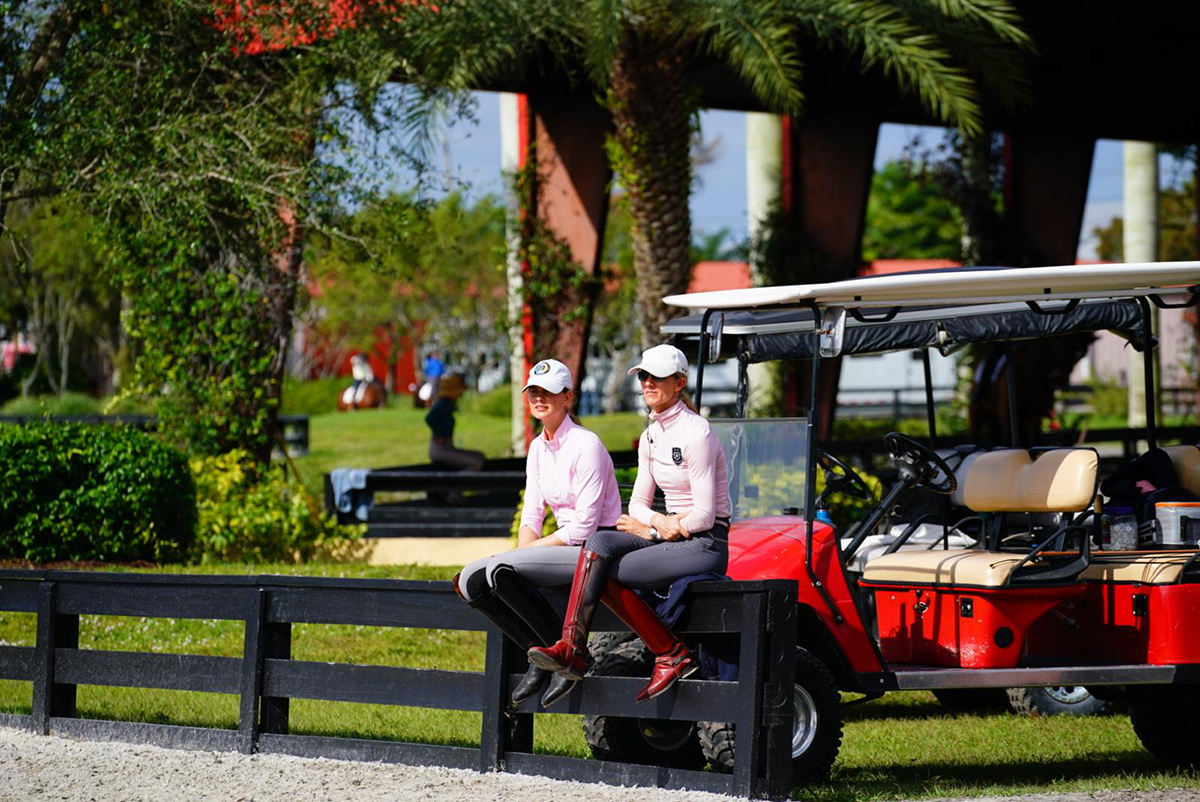
Kelly in her ‘daily pose’ alongside her assistant trainer. Image supplied.
With so many dressage riders, trainers and coaches from Germany spending the European winter in Florida, Kelly is spoilt for choice when it comes to training herself. She still gets help from Bennet Conn, who found her original Amoucheur. Kelly says that Ben has come a long way and has a fantastic eye for getting a horse through and straight. “With this feeling, Grand Prix becomes easier. He picks on me a lot and I love the intricacies,” she says.
One drawback to living in Florida is they did lose their house, which was flattened in the tornado last October! Never say never, they are renting a house a few minutes from the barn that is a client’s until they can rebuild.
TWO UP-AND-COMING HORSES
Besides her clients’ horses, Kelly has two up-and-coming stars of her own: a nine-year-old mare, Quinta, and 10-year-old gelding, Living Diamond, that she’s brought on for the last five years at her pace. She has only competed the gelding, but both are doing all the Grand Prix movements.
“The mare, Quinta, is by a Quando-Quando sire out of a Romanov x De Niro mare. She’s extremely sensitive and early on a little scary, I have to say. We have developed a great understanding, and she doesn’t suffer fools or mistakes. She gives her all and I cannot afford to make a mistake any day that I ride her. She expects perfection; she is so sharp and powerful and is so good for my mental and physical state. She’s very, very exciting. I haven’t even shown her yet, but she does all the Grand Prix movements.
“The gelding is Living Diamond and I rode him in the Future Stars Grand Prix last year where he came third in the final where he was first out. It was amazing to be up with the very best of the best. He has fantastic piaffe and passage, and such a good brain, sensitive and energetic… but if you drop the reins, he just walks. He’s about 16.1 hands high and suits me perfectly.”
Kelly again qualified for the Lövsta Future Challenge Final this year at Global Dressage Festival 12 with Living Diamond, finishing third. At the same event, Kelly and Living Diamond also contested the USEF Developing Horses Grand Prix at Global Dressage Festival 12; the only combination to take part, they scored an impressive 70.625%. A class for 8- to 10-year-old USA-owned and ridden horses, the USEF Developing Horses Grand Prix was a qualifier for the final at the Festival of Champions, to be held at HITS Lamplight Equestrian Center in Wayne, Illinois (18-24 August 2025). “They only take the top 15 combinations for the final,” explains Kelly. “I still need to do more qualifiers; the ranking is based on your average, and you can only drop one score.”
CHANCE TO MOVE FORWARD
In recent times, Kelly has made the decision to now ride under the USA flag. It’s a choice that she feels will avail greater opportunities for herself and her horses moving forward.
“I really needed some help with funding and training,” she explains. “To be able to work towards being eligible for these grants, alongside the fact that it’s my family’s nationality – Steve has always been keen for me to be an American – were the reasons I made the change.
“I have to say it was a nice thing to be the chef d’equipe for the recent Australian FEI Dressage Nations Cup comprised of Jemma Heran, Hope Beerling and Sally Lofting just before changing nationalities. A great memory and what great riders.”
Kelly says it really dawned on her a few months ago that her two horses could really be something, and that has also driven the change. “I would like to put them on a better path and join in and be in the pipeline that they have here towards grants and training. This helped me make the decision, for sure, but remember, I’ve also lived here for 17 years and it is really home now. It certainly wasn’t easy, and it was nothing at all against Australia.
“At 49 I figure I’ve got 10-odd good years left, and I want to make the most of it. I have two good horses that I want to produce to the best I can do. The grants and funding and help from the United States Equestrian Federation is amazing and I could be part of that, so why not have a go? I don’t want to do it alone anymore. I want to feel part of a team. I’ll be drawn along by the enthusiasm, and that certainly is here.”
“For example, if Living Diamond gets into the Future Stars Grand Prix finals now as an American-owned and American-ridden horse, we will have the opportunity to be eligible for some fantastic grants for training. For me, I’ve been amongst these people for a long time, but I’ve never been eligible for any grants for training as I wasn’t an American. If you are in the top 12 [at Grand Prix level], the USEF takes three teams (A, B & C) to Europe fully funded… fully funded and wow, perhaps that goal may be achievable for me.
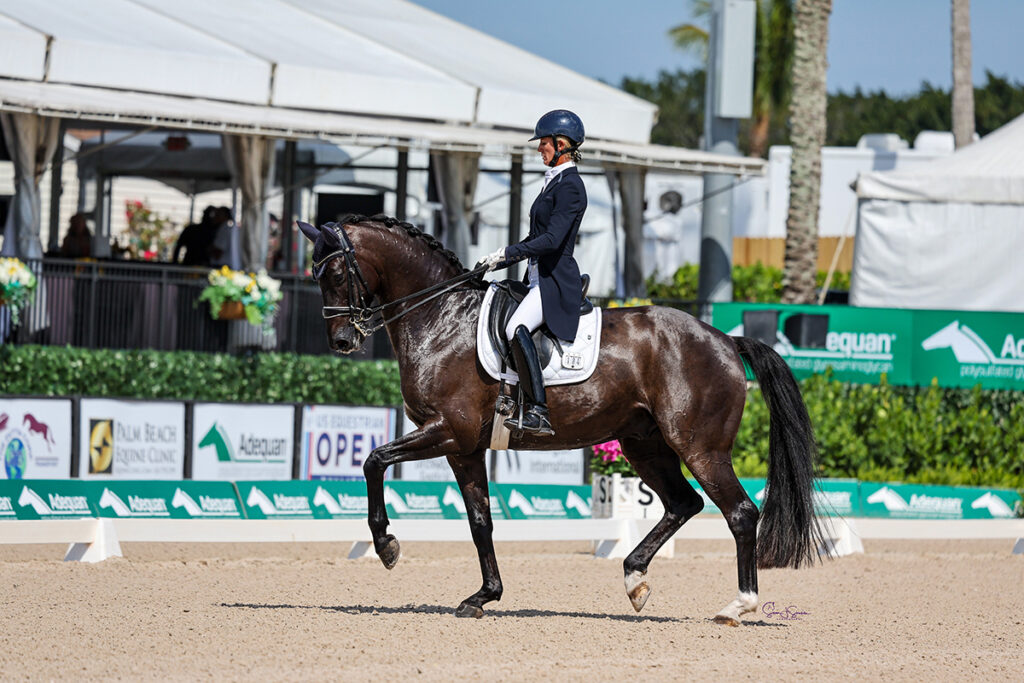
Kelly and Living Diamond winning their Lövsta Future Challenge Final qualifier at Global Dressage Festival 10 in March. Image by Susan J Stickle Photography.
“There is also a lot of work for young rider coaches and young horse coaching and so on, and to be American puts you in with a chance at greater opportunities. I feel I need to move forward and try to make the most of the opportunities that avail themselves here. It was a very big decision to make to change my nationality from Australian to American, but what was I to do to move forward? Having lived here for such a long time, I feel part of the country now. I’ll always be Australian at heart, but my nationality with my husband is American.
“It was a little scary making the change. While I was no immediate threat to any American’s team spot, I wondered if people may think ‘why the change’? It was actually the opposite and so many people have come to say how fabulous that I am now an American citizen. It was so nice.”
‘I LOVE AUSTRALIA’
“I think the people are fantastic where I grew up, but I haven’t been back for five years,” says Kelly of her birth country. “I could only see myself coming back to retire as the pace is a little slower. I love Australia and I can see myself absolutely retiring there.”
With a life revolving around horses, Kelly says there’s not a lot of time for any other activities – not that she minds. “Well, horses are my life. Horses are our lives. I have to be honest and say what I love spending the time doing the most when away from the stables is editing videos of horses and horse training; it helps me relax. That might sound strange, but I truly find it relaxing and totally enjoyable. I love to get behind the screen and edit videos and especially taking all the positives from the training. I’ve edited videos I use to help my students, always the positive things are brought to the forefront, and it’s looking at the good things that we say, ‘wow, was that me? That really did look good’ that makes life worth living with horses.” EQ
